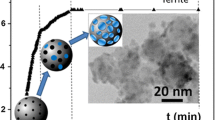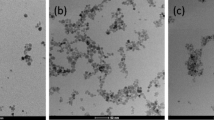Abstract
Zinc-iron oxide nanoparticles (ZnxFe3−xO4 and δ-ZnxFe1−xOOH) were successfully synthesized by room temperature chemical reaction of a solution containing ZnCl2 and FeCl2 in the presence of gelatin. The composition of products could be controlled by variation of the Zn/Fe mixture ratio of the starting material. ZnxFe3−xO4 nanoparticles were obtained from a solution with a high Zn/Fe ratio, whereas Zn-doped feroxyhyte (δ-ZnxFe1−xOOH) nanoparticles were obtained from a solution with a low Zn/Fe ratio. The ZnxFe3−xO4 nanoparticles were spherical with diameters of approximately 10 nm, and the δ-ZnxFe1−xOOH particles were needle-like with lengths of approximately 100 nm. Mössbauer spectra measured at room temperature indicated superparamagnetic behavior of the nanoparticles, whereas the magnetic components were observed at low temperature. The Zn content of the intermediate species (\((\text {Zn}^{\text {II}}_{\mathrm {x}}\text {Fe}^{\text {II}}_{\mathrm {1-x}}\text {Fe}^{\text {III}}_{\mathrm {2}}\mathrm {O}_{4})\)) plays an important role in the oxidation process. When the Zn concentration was high, the content of Fe2+ in the intermediate species was small, and Zn2+ prevented further oxidation of the nanoparticles. When the starting material had low Zn concentration, the amount of Fe2+ in the intermediate species became large and was rapidly oxidized into δ-ZnxFe1−xOOH while rinsing under the ambient atmosphere.
Similar content being viewed by others
References
Liu, X., Liu, J., Zhang, S., Nan, Z., Shi, Q.: Structural, magnetic, and thermodynamic evolutions of Zn-doped Fe3O4 nanoparticles synthesized using a one-step solvothermal method. J. Phys. Chem. C. 120, 1328–1341 (2016)
Zhu, J., Nan, Z.: Zn-doped Fe3O4 nanosheet formation induced by EDA with high magnetization and an investigation of the formation mechanism. J. Phys. Chem. C. 121, 9612–9620 (2017)
Liu, J., Bin, Y., Matsuo, M.: Magnetic behavior of Zn-doped Fe3O4 nanoparticles estimated in terms of crystal domain size. J. Phys. Chem. C. 116, 134–143 (2012)
Schwertmann, U., Cornell, R.M.: Iron Oxides in the Laboratory: Preparation and Characterization. Wiley-VCH Weinheim, Germany (2000)
Polyakov, A.Y., Goldt, A.E., Sorkina, T.A., Perminova, I.V., Pankratov, D.A., Goodilin, E.A., Tretyakov, Y.D.: Constrained growth of anisotropic magnetic δ-FeOOH nanoparticles in the presence of humic substances. CrystEngComm 14, 8097–8102 (2012)
Pereira, M.C., Garcia, E.M., Silva, A.C., Lorencon, E., Ardisson, J.D., Murad, E., Fabris, J.D., Matencio, T., Ramalho, T.C., Rocha, M.V.J.: Nanostructured δ-FeOOH: a novel photocatalyst for water splitting. J. Mater. Chem. 21, 10280–10282 (2011)
Nishida, N., Amagasa, S., Kobayashi, Y., Yamada, Y.: Synthesis of superparamagnetic δ-FeOOH nanoparticles by a chemical method. Appl. Surf. Sci. 387, 996–1001 (2016)
Nishida, N., Amagasa, S., Kobayashi, Y., Yamada, Y.: One-pot production of copper ferrite nanoparticles using a chemical method. Hyperfine Interact. 237, 111 (2016)
Rubinstein, M., Forester, D.W.: Investigation of the insulating phase of magnetite by NMR and the Mössbauer effect. Solid State Commun. 9, 1675–1679 (1971)
Ito, A., Ono, K., Ishikawa, Y.: A study of the low temperature transition in magnetite. J. Phys. Soc. Jpn. 18, 1465–1473 (1963)
Li, Y.H., An, S.Y., Kim, C.S.: Study of site occupancy in ZnxFe3−xO4 microspheres based on Mössbauer analysis. IEEE. T. MAGN. 49, 7 (2013)
Ferrari, S., Aphesteguy, J.C., Saccone, F.D.: Structural and magnetic properties of Zn-doped magnetite nanoparticles obtained by wet chemical method. IEEE. T. MAGN. 51, 6 (2015)
Author information
Authors and Affiliations
Corresponding author
Additional information
This article is part of the Topical Collection on Proceedings of the International Conference on the Applications of the Mössbauer Effect (ICAME 2017), Saint-Petersburg, Russia, 3-8 September 2017 Edited by Valentin Semenov
Rights and permissions
About this article
Cite this article
Ito, H., Amagasa, S., Nishida, N. et al. Wet chemical synthesis of zinc-iron oxide nanocomposite. Hyperfine Interact 238, 79 (2017). https://doi.org/10.1007/s10751-017-1442-6
Published:
DOI: https://doi.org/10.1007/s10751-017-1442-6




